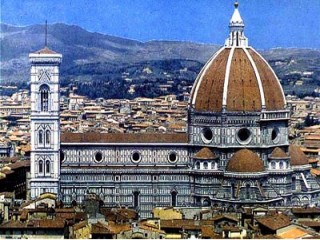
Filippo Brunelleschi biography
Date of birth : -
Date of death : 1446-04-15
Birthplace : Florence, Italy
Nationality : Italian
Category : Arhitecture and Engineering
Last modified : 2010-04-16
Credited as : Architect and sculptor of the Early Renaissance, engineer, Basilica di San Lorenzo di Firenze/Santo Spirito di Firenze
32 votes so far
Very little is known about the early life of Brunelleschi; the only sources are Antonio Manetti and Giorgio Vasari. According to these sources, Filippo's father was Brunellesco di Lippo, an Italian lawyer, and his mother was Giuliana Spini. Filippo was the middle of their three children. The young Filippo was given a literary and mathematical education intended to enable him to follow in the footsteps of his father, a civil servant. Being artistically inclined, however, Filippo enrolled in the Arte della Seta, the Silkmakers' Guild, which included goldsmiths, metalworkers, and bronze workers. He became a master goldsmith in 1398. It was thus not a coincidence that his first important commission, the Foundling Hospital, came from the same guild to which he belonged.
In 1401, Brunelleschi entered a competition to design a new set of bronze doors for the baptistery in Florence. Along with another young goldsmith, Lorenzo Ghiberti, he produced a gilded bronze panel, depicting the Sacrifice of Isaac. His entry made reference to a classical statue, known as the 'thorn puller', whilst Ghiberti used a naked torso for his figure of Isaac. In 1403, Ghiberti was announced the victor, largely because of his superior technical skill: his panel showed a more sophisticated knowledge of bronze-casting; it was completed in one single piece. Brunelleschi's piece, by contrast, consisted of numerous pieces bolted to the back plate. Ghiberti went on to complete a second set of bronze doors for the baptistery, whose beauty Michelangelo extolled a hundred years later, saying "surely these must be the "Gates of Paradise."
As an architect
Brunelleschi's first architectural commission was the Ospedale degli Innocenti (1419-ca.1445), or Foundling Hospital. Its long loggia would have been a rare sight in the tight and curving streets of Florence, not to mention its impressive arches, each about 8 m high. The building was dignified yet sober. There were no displays of fine marble and decorative inlays. It was also the first building in Florence to make clear reference—in its columns and capitals—to classical antiquity.
Soon other commissions came, the most important of which were the designs for the dome of the Cathedral of Florence (1419-1436) and the Sagrestia Vecchia, or Old Sacristy of S. Lorenzo (1421-1440). The complex history of Santa Maria del Fiore need not be recounted except to state that by 1418 all that was left to finish was the dome. The problem was that when the building was designed in the previous century, no one had any idea about how such a dome was to be built, given that it was to be even larger than the Pantheon's dome in Rome and that no dome of that size had been built since antiquity. Because buttresses were forbidden by the city fathers, and clearly was impossible to obtain rafters for scaffolding long and strong enough (and in sufficient quantity) for the task, it was unclear how a dome of that size could be built, or just avoid collapse. It must be considered also that the stresses of compression were not clearly understood at the time, and the mortars used in the periods would only set after several days, keeping the strain on the scaffolding for a very long time. In 1419, the Arte della Lana, the wool merchants' guild, held a competition to solve the problem. The two main competitors were Ghiberti and Brunelleschi, with Brunelleschi winning and receiving the commission.
Of the two churches that Brunelleschi designed, the Basilica di San Lorenzo di Firenze(1419-1480s) and Santo Spirito di Firenze(1441-1481), both of which are considered landmarks in Renaissance architecture, the latter is seen as conforming most closely to his ideas.
Principal works
The principal buildings and works designed by Brunelleschi or which included his involvement:
- Dome of the Cathedral of Florence, (1419-1436)
- Ospedale degli Innocenti, (1419-ca.1445)
- Basilica di San Lorenzo di Firenze, (1419-1480s)
- Palazzo di Parte Guelfa, (1420s-1445)
- Sagrestia Vecchia, or Old Sacristy of S. Lorenzo, (1421-1440)
- Santa Maria degli Angeli: unfinished, (begun 1434)
- The lantern of the Florence Cathedral, (1436-ca.1450)
- The exedrae of the Florence Cathedral, (1439-1445)
- Santo Spirito di Firenze, (1441-1481)
- Pazzi Chapel, (1441-1460s)



















